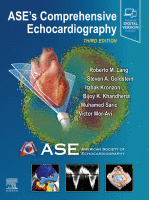Physical Address
304 North Cardinal St.
Dorchester Center, MA 02124

Acknowledgment The authors acknowledge Dr. Paul Szmitko, who was the first author of this chapter in the second edition of the textbook. The pathophysiology of hypertrophic cardiomyopathy (HCM) involves several abnormalities that can be assessed using echocardiographic Doppler techniques. Structural…

Hypertrophic cardiomyopathy (HCM) is characterized by the presence of left ventricular (LV) hypertrophy in the absence of another cardiac or systemic etiology. It is a genetic condition with an autosomal dominant inheritance, affecting 1 in 500 individuals of the general…

Cardiovascular disease, in particular coronary artery disease (CAD), remains the leading cause of death worldwide. There is also enormous burden on health care systems. Annually, 10 million stress tests and 1 million invasive cardiac angiograms (ICAs) are performed in the…

Stress echocardiography (SE) has been less well validated in the context of aortic regurgitation (AR) and mitral stenosis (MS) than for coronary disease and mitral regurgitation (MR). In both these conditions, exercise stress echocardiography (ESE) represents the imaging approach of…

Ultrasound-Enhancing Agents for Stress Echocardiography In the updated 2018 guidelines for ultrasound-enhancing agents (UEAs), it was recommended that UEAs be used whenever a coronary artery territory cannot be completely visualized on unenhanced echocardiography. This becomes especially relevant during stress echocardiography…

Introduction and General Concepts There has been a dramatic change in the acute presentation, chronic consequences, and mode of death related to coronary artery disease (CAD) in the past few decades. The rapid recognition of acute coronary syndromes and increased…

Stress echocardiography (SE), first introduced in 1979, was initially introduced for the detection of obstructive coronary artery disease (CAD). The underlying principle is that ischemic myocardium is unable to augment in function during stress. The severity and distribution of myocardial…

You’re Reading a Preview Become a Clinical Tree membership for Full access and enjoy Unlimited articles Become membership If you are a member. Log in here

General Test Protocol During stress echocardiography (SE), electrocardiographic leads are placed at standard limb and precordial sites, slightly displacing (upward and downward) any leads that may interfere with the chosen acoustic windows. A 12-lead electrocardiogram (ECG) is recorded in resting…

The main sign of ischemia during stress echocardiography (SE) is the transient regional wall motion abnormality (RWMA) caused by a flow-limiting coronary artery disease (CAD). RWMA can be provoked by exercise or pharmacologic stressors, either by increased myocardial oxygen demand…